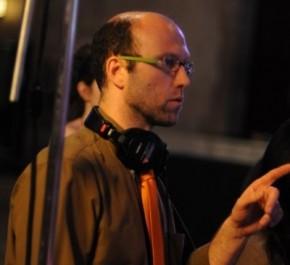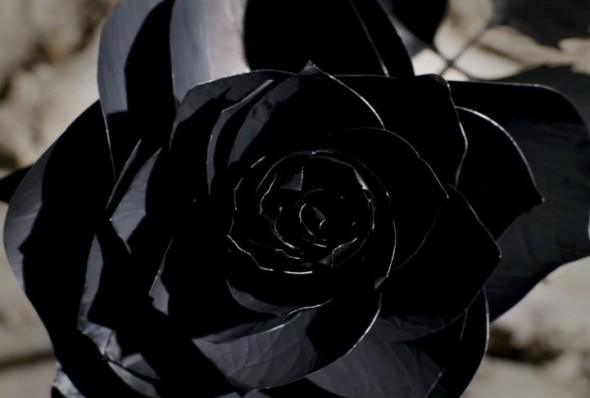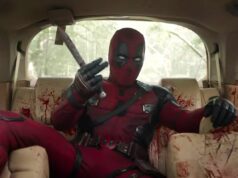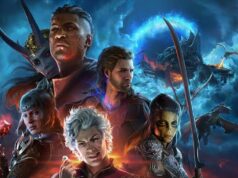 Lapo Melzi is an award winning writer, director, and animator. In honour of Black History Month, Lapo’s latest animated commercial, “Black Rose,” has won honors in the 2010 AICP Show “The Art & Technique of the American Commercial” and is now part of the permanent media collection of MoMA, while his first feature animation script, Quigely, was named the Vision Award Winner in Gimme Credit’s 2009 International Screenplay Festival.
Lapo Melzi is an award winning writer, director, and animator. In honour of Black History Month, Lapo’s latest animated commercial, “Black Rose,” has won honors in the 2010 AICP Show “The Art & Technique of the American Commercial” and is now part of the permanent media collection of MoMA, while his first feature animation script, Quigely, was named the Vision Award Winner in Gimme Credit’s 2009 International Screenplay Festival.
Lapo’s work has been showcased in multiple festivals and award shows in the last several years. He is currently in post-production on a documentary he directed about domestic violence. He is also developing a television miniseries script about the Norwegian resistance during War World II, as well as collaborating on a television comedy pilot.
You can watch “Black Rose” here, amongst Lapo’s other works.
We spoke with Lapo about the world of animation and his work on”Black Rose”, writing a script for Aliens VS Predator, and future projects.
What were your favourite animations as a child?
I grew up watching Japanese animation, Chinese kung-fu movies and American movies. For some strange reasons Italy has a direct connection with Japan, when it comes to animation, so I grew up watching some of the greatest anime that came out of Japan. Series like Future Boy Conan (Miyazaki’s first work as an animator), Kyashan, Hurricane Polymar, Orange Road, Touch, Robotech, Babyl Junior left a great impression on me. Especially Future Boy Conan has remained as one of my favorite animations ever: the story was amazing, the world invented was great and Miyazaki’s drawing style and animation were unique and personal.
The classic Disney was also close to my heart, with “101 Dalmatians” and “The Fox and the Hound” as my favorites.
When I was younger stop motion wasn’t treated as animation, so there weren’t any feature length animations available in that style. Nevertheless I had the luck to be exposed to it. One of my greatest loves in fact were Ray Harrihausen’s movies. I am still in complete awe of the man today. I LOVE “Jason and the Argonauts” and love “Clash of Titans” and “The Seventh Voyage of Sinbad.” The image of the Medusa looking for Jason is still burnt in my head. The incredible talent of Harrihausen probably exercised the strongest influence in my appreciation of stop motion. He made inanimate objects alive–breathing, fighting, loving. He still is the God of Animation for me (and a whole generation of animators and fans of animation.)
I also have many more influences, but these cover my younger years. Later on I was exposed to the work of Nick Park, Brad Bird, Pixar and loved it thoroughly.
Did your passion stem from since then or was it something that you realized later with deeper interpretation?
Animation has always been a great love of mine, but I never thought I could animate myself. I can’t really draw, so I thought that I lacked the basic skills to become an artist animator. When I was a student at NYU, though, I was asked to produce a short MOS (a silent movie without dialogue, or music) and I was encouraged to “experiment”. I have always been a great fan of the Muppet show and always wanted to create an original story with original characters that I could call my own. I was also finally reaching my maturity in terms of storytelling ability and wanted to demonstrate a theory that had in mind. I thought that if I really knew what a story is and how is work, then I could write a story about two inanimate characters and make the audience feel for them. A muppet story seemed the perfect medium to test this theory, so I proceeded and wrote a short love story between two inanimate puppets and tested my theory. I was very pleased to see that I was right. I one fell swoop, I reached a new level of confidence in my writing and created two characters that I loved.
Despite this, stop motion animation, still seemed to require magical powers and abilities that I didn’t possess. I kept on writing several animated projects and I tried to get animators involved, but only succeeded in realizing my animation “Paper Child,” a public service announcement against child abuse that won me a place in the prestigious 2009 Best Directors Showcase and was a finalist in the AICP show. At this point, I really wanted to continue on producing more animation, so I prepared a series of new projects, but was unable to obtain the support of animation artists. As a result, I was faced with two choices: giving up and waiting until I had enough money to involve talented animators, or risk it all and do it myself. I’d never been good at giving up, so I put everything I knew about animation to use and proceeded to animate a very complicated sequence about a black rose growing. Fifteen days later, I emerged with my thirty second piece “Black Rose”—my fist animation. The result far exceeded my wildest expectation about my animating abilities.
As both a director and animator, how long does it roughly take to create one of these short films?
It depends on the project. Black Rose took 15 days to design and animate (16 hours days with 4 overnights—more akin to a month and a half in a real working environment. The first week was solely dedicated to make the broken sidewalk, make all the different rose parts and figuring out an efficient design that would allow me to animate it without losing my mind. The second week was all about the shooting and animation. I am a fairly quick animator, but a lot of time needs to be spent streamlining and simplifying the project, so that I can handle it myself.
Black Rose is your latest work, produced by third year student Kiara Jones – what was the main message you both wanted to portray in the animation?
With ‘Black Rose’ we wanted to depict the beauty, strength and resiliency of African American people but found ultimately that the animation meant so much to Black people everywhere. I wanted to deliver the message in a creative, thought provoking way, so I decided to create a metaphor for the struggle that the African American and Black people often go through every day in order to show their unending resiliency. The project was born from listening for the first time to Ben Harper’s song “I’ll Rise”, with lyrics from Maya Angelou’s poem. The song captivated me and I immediately envisioned a bud striving to grow, despite the vicious attempts to destroy it. I struggled for a while, deciding whether it should be 2D animation, 3D, or stop motion and I finally settled on stop motion. At the point Kiara had already produced a couple of my projects and we had an ongoing relationship. Kiara is African American of Jamaican descent and the project really resonated with her. I was glad, because being an Italian I was never sure how African American and Black audiences would take ‘Black Rose’. I was worried they might be offended or find my attempt presumptuous. I was elated when Kiara gave me her full support. As in every other project we have done together, she was great in giving me support and creative freedom.
Are you happy with the reviews it has received?
Yes, I am very happy with the reviews ‘Black Rose’ has received so far. All the people who have seen it were impressed by the beauty of the piece, the quality of the animation and thought provoking, on the point delivery of the message. Those are all the thing that I was aiming for, so it has been extremely satisfying to see the audience react in exactly the way I hoped that they would.
You won a prestigious AICP prize, tell us what that has meant to you and your career?
Winning the AICP award was extremely important for my career. The AICP show is the most important advertising show in the America, and winning, lent me a measure of recognition from the professionals in the industry, plus some bragging rights! Thanks to the award and thanks to the help of Roberta Griefer (Editorial Director and Publisher of Shootonline) and my professor Laura Belsey, I was able to obtain representation from Blah Blah Blah (www.blahusa.com), a rep agency that represents among others Aardman Animation, Blur studios, Motion Theory (all companies that I admire wholeheartedly). Roberta Griefer and Andy Arkin (my rep at Blah Blah Blah) also introduced me to the post production house Nathan Love (www.nathanlove.com, with which I am now starting a collaboration: I am their first director on their rooster and I will take care of both live action and animation projects for them. It’s a really exciting collaboration, because Nathan Love will allow me to grow with them and expand my abilities as they expand their reach in the industry. So, definitely, the AICP award has changed a lot for me.
Please tell us the background of how MTV/VH-1 and BET came to use Black Rose on their networks? Did you have a relationship with them prior to this?
I didn’t have any relationship with MTV or BET. After years of being told how impossible it is to get in the industry and how you have to get into festivals and do certain things in a certain order, I just got tired. I thought that I had a high quality product, so together with Kiara we decide to submit to all the channels or company that we thought would be interested. We got a lot of rejections, but we never stopped hustling. At a certain point, Kiara acquired a contact at BET, so we just used our powers of persuasion until they watched Black Rose and agreed to air it. I found that hustling works much better for me, instead of waiting to be discovered by someone.
What has been the most challenging film you’ve worked on?
Apart from my live action short film “Romeo Vs. Juliet”, I think Black Rose has been the most challenging. Black Rose was the first project ever where I had full control: I wrote it, designed it, made it (except for the sidewalk and the full bulb of the rose at the end, that my Prod Designer Chloe Reisen made) animated it, directed it, edited it. I went into the project with the knowledge that I could completely fail. I was win or die trying. It was nerve wreaking, but also extremely exciting. I was alone for most of the process and when I finally watched the completed animation, tears welled up in my eyes: from exhaustion, exultation and just genuine joy.
How did you come to write a treatment for Alien vs. Predator? Is a career in sci-fi something you would like to continue with?
I have previously used Sci-Fi themes in my work and I decided to get in touch with director of commercials Dario Piana. Dario was and is famous for his knowledge in special effects and his passion for science fiction. I introduced myself and my work to Dario, he liked my work and we became friends. As we got to know each other more, I showed him my scripts. At that time Dario was working on getting his break in the American market, directing his first feature. He was becoming friends with Stan Winston (extremely famous Special effect artist) and was in talks with Twenty Century Fox while they were developing ‘Alien vs. Predator’. Twenty Century Fox was looking for new concepts for the movie, and they asked Dario if he wanted to propose an idea. Dario is not a writer, so he turned to me. I have always been a fan of ‘Alien,’ ‘Aliens’ and ‘Predator’, so I was extremely excited to write a story for it. I ended up developing a treatment for Dario, which was sent to the Executives of Twentieth Century Fox. In the end they didn’t go with my idea, but they sent a letter of appreciation for my treatment.
Do you agree that messages are more powerful visually without any words being said?
Yes, I do agree. When moving images are used in their pureness, without the help of words, they rise to completely different heights. They become a language of their own and you can feel the meaning behind them. Even without hearing the words you can can feel the message which gives it a deeper impact. It’s a really strange and wonderful phenomenon: the true power of moviemaking.
Looking at big animation movies, such as Toy Story, do you have plans for something different in the future?
I had the chance to speak with Henry Selick, the creator of ‘Coraline’, during a Q & A. He pointed out that thanks to 3D there are now more stop motion projects being realized in the world than ever before.
This means that nowadays a filmmaker has an arsenal of options of his stories: live action, animation (2D, 3D, stop motion).
I have different projects that I am developing that will work well in different styles. Right now I have my sci-fi feature animation script ‘Quigley’ that was designed for 3D. ‘Quigley’ tells the story of a pet flying squirrel who becomes a superhero with the help of an ex-experiment mouse, in order to help the squirrels of Central Park fight against the tyranny of a gang of evil pigeons. The script won the Artistic Vision Award at the Gimme Credit International Screenplay Festival. I just finished a polish of the script for them and soon they will send it out for consideration to their network of agents and managers. In my drawer are other 3D, stop motion and 2D animation projects, together with live action ones.
Tell us a bit about other current and future projects?
Right now I have just finished writing two short children stories. I’m also writing the outline for a Norwegian Resistance piece which I hope to get funding for so I can develop it properly. It is a miniseries of 3 to 5 episodes and it came into being after I chanced upon the book, “We Die Alone” by David Howarth. It’s an incredible survival story of Jan Baalsrud, who was the only survivor of a Norwegian commando team ambushed by the Nazis during World War II. I’m also finishing production on ‘Serenity’ a human drama documentary set to explore the issue of domestic abuse and the struggles the victims and their families face daily as they navigate their way to recovery. Framed by the cornice of Serenity House, a temporary shelter for abuse victims and their families, the documentary explores the endeavors, challenges, triumphs and setbacks that these individuals face as they try to retake control of their lives and escape the cycle of violence. I started shooting the documentary last November.
Interview by Saima Azam














